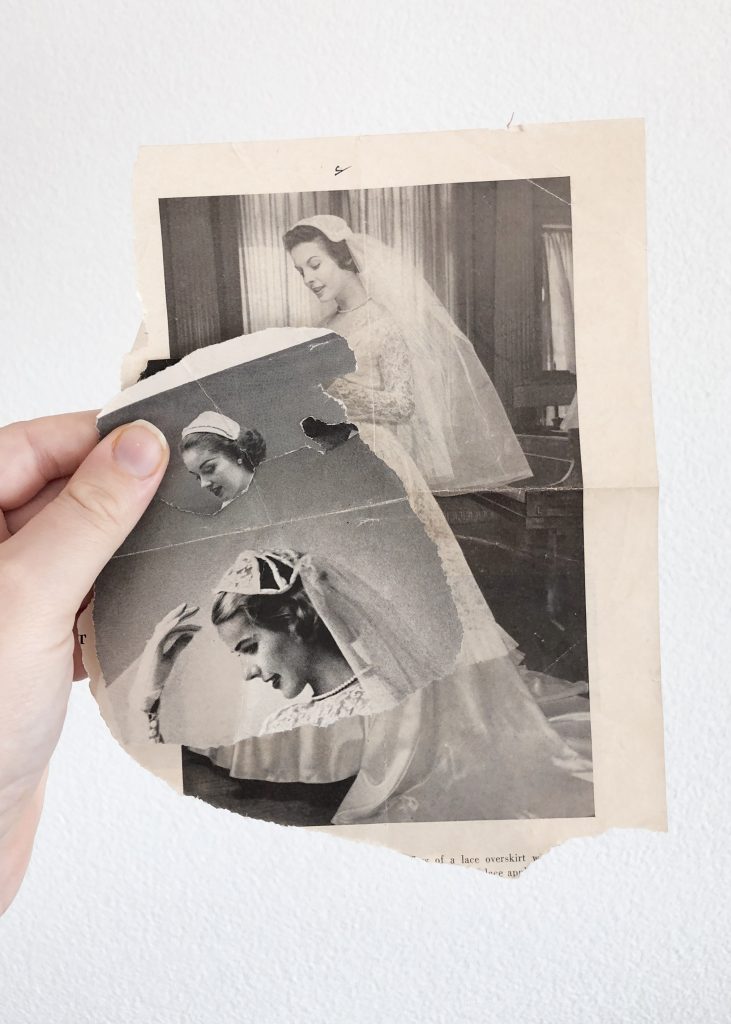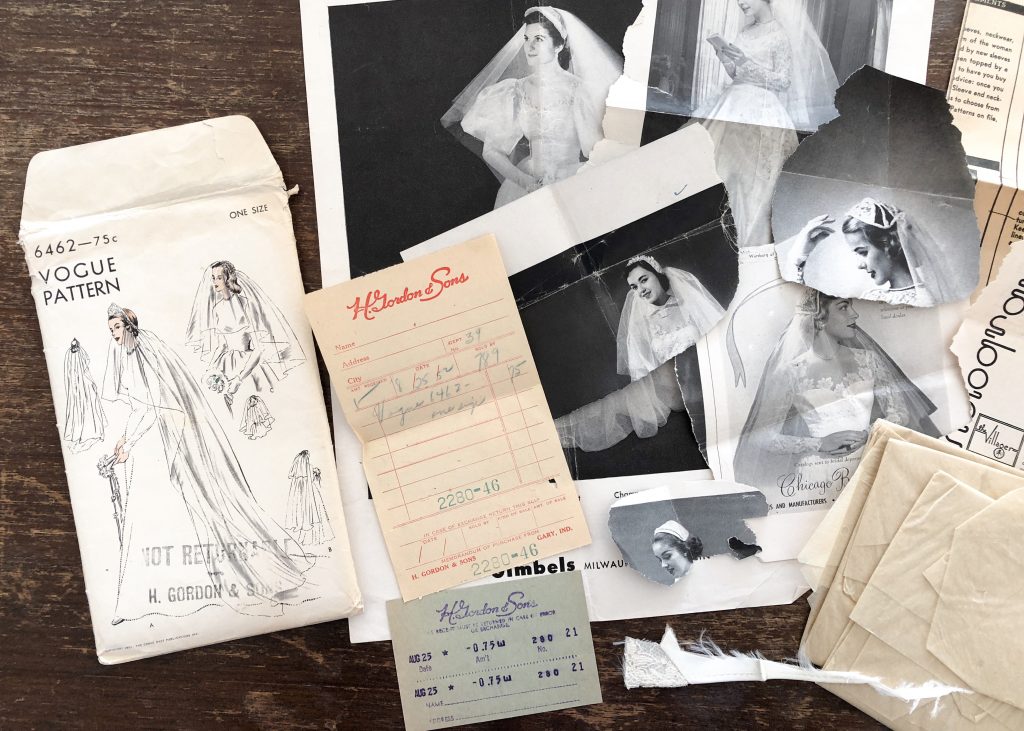I love to sew, and for several years, I assumed I’d make my own wedding dress. My mom sewed her own dress, and while it’s not my style (she wore a red knee-length dress to her wedding, and, ironically, I’m a bit more traditional), I love feeling linked to past generations and their love stories. When my partner Ken and I got engaged last February, I immediately thought of sewing a dress like my mom did, carrying forward a tradition. So, a few months ago, I ordered a few sewing patterns for dresses and veils online. All of the patterns were new, except one — a vintage veil pattern from the 1950s, which I found on an online marketplace. Most vintage patterns are uncut and in good condition, so I didn’t think much about buying a 65-year-old pattern, and I placed the order.

I had the patterns sent to a friend’s house, to bring with her on her next trip. I grew up in America, but moved to the Netherlands last year, and the shipping and import tax rates for international orders can quickly double the cost of an item. So, whenever I have a friend who’s planning a visit to me, they double as Gift Mule, and I order any clothes, books, or (in this case) sewing patterns to their house for them to bring with them. In this case, the Gift Mule was my friend Maya. All the new patterns arrived in time for her flight, but the vintage pattern came a few days late, meaning she’d have to ship it to me after she returned to the States. During Maya’s visit, we went wedding dress shopping and found a dress I loved, so the pattern didn’t cross my mind for a few months. But, several weeks ago when Maya was sending me some pumpkin-flavored cookies (you can take the girl out of America, but you can’t take America out of the girl), she found the remaining pattern and sent that, too.
Maya’s box arrived in late September, and so did the pattern, wrapped in a clear plastic envelope for safekeeping. By this point, it was fall and I knew I would be buying my dress, rather than making it. So, the pattern sat unopened in my office for a week or two as I made my way through the box of pumpkin goods.
Until last night.
I spent most of yesterday wedding planning. As I planned hairstyles and accessories, I realized how expensive it was to buy a veil, and how easy they were to make compared to a dress. I had several veil patterns lying around, so I got my patterns together and started absent-mindedly going through them, while talking to a friend on the phone. I loved the style of the vintage veil, but I wasn’t sure if the pattern had been cut already, so I opened the envelope to check. When I did, I was surprised to find a lot more than just the pattern.

As I pulled out the contents of the envelope, several slips of paper fell out, as well — pictures torn out of black-and-white wedding magazines, with little checkmarks next to some. I also found a receipt and a little card, hand-printed with the date that the original owner had bought the pattern: August 25, 1952.

And, when I looked into the envelope to see if I had missed anything, I found a scrap of ivory fabric: satin and lace sewn together, clearly cut from the hem of a wedding dress.

My heart jumped. I’m a total romantic, and I could just feel the excitement and hope in this envelope, full of dreams for a wedding that must have been planned some 60 years ago. I wondered about the previous owner. The envelope had a name on the front, which I first thought was the name of the designer who had collaborated with the pattern company. But I realized from the angle of the name and the color of the ink that it was actually the name of the previous owner, written by hand: Vera Philips. The pictures torn out of magazines made me feel strangely tied to her; they reminded me of the collages I made of my own wedding, both as a teenager dreaming of the future, and as a young woman planning her wedding day today. Seeing Vera’s hopes in this envelope made me feel like I had a glimpse of her same happiness and excitement. I wondered who she was, and who she was planning to marry. And, I realized, I couldn’t tell if the pattern had been used. Did she marry him, after all?
I wanted to find out.

Before I continue telling this story, I want to clarify which of the following details I’m going to change. When “Vera” purchased this pattern in 1952, she had no idea that one day, someone else might find it and write about its contents, and she has no way to consent to having her story told now. So, for the sake of her privacy, I’ve changed several nnames, and only kept the necessary details the same. The date of purchase and the city where she bought it have not been changed, nor has the first name of her fiancé — for reasons you’ll see below. But I have changed her name and any other dates to protect her privacy. I’ve also removed her real name from the photos of the envelope in Photoshop. Nothing else has been changed or doctored.
Something about me that I’m not especially public about is my web sleuthing skills. If my friend tells me the first name and college of her Tinder match, I can find his full name, Facebook profile, and five most recent places of employment in less than ten minutes — it’s why I’ve been so careful about some of my own public details on this blog. But finding Vera would be a little more challenging. All I knew about her was her maiden name, and the date and department store where she bought the pattern. Still, I wanted to know her story; and, more specifically, whether it had a happy ending. So, I got to work.
The first thing I found was that the store where she bought the pattern was based in Gary, Indiana. So I did some searching for public records in Gary from around the time that Vera bought the pattern. But while Vera Philips was a surprisingly common name, I couldn’t find a Vera Philips in Gary — only one the next town over, who would have been in her forties when the pattern was bought. Women usually married in their early twenties at this time, so I thought it wasn’t likely to be her, though I couldn’t be sure. There were Vera Philips all around Indiana in the 1950s, it seemed, but none in Gary. Maybe she had driven to Gary to buy it? It seemed unlikely — Gary was a steel mill town, so if she had wanted to go to a store with more selection, she would probably have gone to a bigger nearby city.

With some further digging, I found a census record from 1930 in Lake County that had a Vera Philips in it as a newborn baby, daughter to Frank and Mildred Philips. I found another record of her in 1940, by which time she had a younger brother named Jack. The record said she was in fourth grade, and that her dad worked in a steel mill and her mom was a homemaker. This all seemed promising — if her dad worked at the mill, it would make sense for them to stay in Gary, and if she was 10 in 1940, she would have been 22 when she bought the pattern, a common age to get married at the time. But I couldn’t find any census record of her afterwards, and, when I searched for wedding licenses in all of Indiana in 1952 and 1953, I didn’t find anyone named Vera Philips, which led me to wonder if maybe the pattern hadn’t been used — maybe she hadn’t gotten married at all.
I picked up the envelope again, inspecting her neat handwriting. It was that perfect vintage handwriting that everyone seemed to have back then, except for one thing — the S in Philips was off. It looked more like an I or an E. And then I realized — this pattern didn’t belong to Vera Philips. It belonged to Vera Philipe.
While the name Vera Philips was common in Indiana in the 40s and 50s, there was only one Vera Philipe, and she lived in Gary. And, I was surprised to see, it was the same Vera I’d found on the census records. The census had been written by hand, and the computer that scanned it thought it read ‘last name — Philips.’ But it said Philipe, too, which I confirmed when I found a record of Vera’s birth certificate: born in 1929 to Frank and Mildred Philipe. I found more records, from future censuses and phonebooks, proving she’d lived in Gary in the early 1950s.
Now I was nervous. I was sure I had the right person, but I hoped desperately that this veil had a happy ending — if it didn’t, it wouldn’t feel right to use it myself. So I did another search, this time for marriage licenses in 1952 and 1953 for a Vera Philipe in Gary, Indiana. And I found it. On a Friday in winter of 1952, Vera Eloise Philipe married Kenneth Lloyd Wilson — known as Ken.

I was so happy to see that her dreams for this veil had come true. I wondered if she was still alive — maybe I could return the pattern to her, for a glimpse into her past. But some more digging and I found the obituaries for her and Ken. They were happily married for sixty years before her passing in 2012. Her online obituary had dozens of comments left by neighbors and friends, describing her as generous, kind, and devoted to her faith. Her husband, Ken, never remarried, and passed away a few years later. Together they had several sons and many grandchildren, who might be a bit older than me, now.
Holding these pieces of the past in my hands, it felt like a good omen. Like me, Vera had gone on to marry a Ken. And, they went on to be married for sixty years — longer than either of my parents has been alive. Her dreams for the future, embodied in these scraps of paper and fabric, had gone on to come true. The pattern for this veil played a small part in that love story.
I contemplated contacting her children, offering to mail the pattern to them. Though I couldn’t find any email or social media information, I found a phone number for her oldest son. But, when I called it, the number had been disconnected. And, I realized, maybe it was better that way. It wasn’t as though I had found her wedding dress, or a diary — something that really captured Vera’s essence or her story. And while these old magazine clippings, and the scrap of dress fabric, might mean so much to me as a bride myself, they likely pale in comparison to the many memories and items of Vera’s that her family has now. They don’t need her old magazine clippings to love and remember her, and a phone call explaining this whole story may bring more confusion than joy.
Maybe this story doesn’t end with a reunion, but with the carrying on of a tradition. As I said at the start of this post, I love connecting to the love stories of past generations. This pattern does just that, bridging the gap between one bride and another, sixty-five years apart. So, while I’ll be buying my dress, I’ll be sewing my own veil, using this vintage pattern as my ‘something old.’ And I’m happy to know that, when I wear Vera’s veil to marry the love of my life, Ken, next summer, some part of the love between her and her Ken will live on.






Excuse me while I sob over there.
I know! Such a cool story! Thank you for reading.
Another Sam here, reporting in to say that I too am crying at my desk. What the heck, this is the best!
Aw, thank you for reading, Sam! It’s such a cool story — I feel very lucky to be a small part of it.
This is so romantic and vintage and tear-jerking. Your story has the perfect premise for any historical fiction. You’re a programmer and a crafter? I mean, how talented you are. 🙂
And a writer. : ) Honestly she should write historical fiction some time.
What a wonderful story! I think it is great how the story ends with carrying on a tradition rather than a reunion. For some reason, the fact that both you and Vera fell in love with men named Ken, seems like a great omen. I hope you have a long and happy marriage!
Wow a great story! You were really dedicated to finding more – I can appreciate that.
Congrats on your engagement! xox The Babbling Babe
Ummm if this isn’t the coolest story ever, I dunno what is. It’s romantic and precious and I LOVE that you sleuthed it all out to tell us now! My heart is swelling to the max!
What a beautiful story! I can’t wait to see pictures in future posts of how you’ve incorporated Vera’s fabric into your veil. I’m sure you will be a beautiful bride, and I wish you and Ken all the happiness in the world!
This is such a beautifully told, moving story. What a perfect read for my Saturday morning! I just really love everything about this. What an amazing way to make your special day even more special.